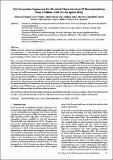Por favor, use este identificador para citar o enlazar a este item:
http://hdl.handle.net/10261/162658COMPARTIR / EXPORTAR:
 SHARE
BASE SHARE
BASE
|
|
| Visualizar otros formatos: MARC | Dublin Core | RDF | ORE | MODS | METS | DIDL | DATACITE | |

| Título: | Next-Generation Sequencing For Microbial Characterization Of Biovermiculations From A Sulfuric Acid Cave In Apulia (Italy) |
Autor: | D’Angeli, Ilenia M.; Waele, J. de; Ieva, Maria Grazia; Leuko, Stefan; Cappelletti, Martina; Parise, Mario; Jurado, Valme CSIC ORCID; Miller, A. Z. CSIC ORCID; Sáiz-Jiménez, Cesáreo CSIC ORCID | Palabras clave: | Geomicrobiology Santa Cesarea Terme Hypogenic cave FESEM 16S rDNA |
Fecha de publicación: | 2017 | Editor: | Australian Speleological Federation | Citación: | Proceedings of the 17th International Congress of Speleology (1) 377-380 (2017) | Resumen: | Sulfuric acid cave systems host abundant microbial communities that can colonize several environments displaying a variety of morphologies, i.e. white flamentous mats foating on the water surface, white creamy moonmilk deposits on the walls, and biovermiculations. Up to date, only few reports have described the microbiological aspects behind biovermiculation geomicrobiology of Italian sulfuric acid caves despite their overall abundance. Here, we present the frst characterization of biovermiculation microbial populations from the Santa Cesarea Terme (Apulia, Italy) using next-generation sequencing and feld emission scanning electron microscopy (FESEM) approaches. We focused our analysis on biovermiculations from Fetida Cave located along the Adriatic Sea coastline. Tis cave is at sea level, and moving from the entrance to its inner part, it is possible to observe a decrease of marine infuence accompanied by a corresponding increase in the acidic efect of the upwelling waters. Biovermiculations are copiously observed covering the ceiling and walls mainly in the inner and middle environments of the cave, while they are absent near the entrance. Biovermiculations have a widespread range of colors going from grey to dark brown with an overall slimy appearance; dendritic morphologies alternate to very dense wall-covering sheets. Total DNA was extracted from each sample and 16S rDNA sequences were analyzed through Ilumina MiSeq platform. Te main lineages found in all the samples included Gammaproteobacteria, Betaproteobacteria, Alphaproteobacteria, Bacteroidetes, Planctomycetes, Actinobacteria and Acidobacteria. In particular, the samples from the inner part of the cave had the highest abundance of Acidobacteria and showed the presence of Epsilonproteobacteria that can be related to bacterial sulfuroxidizing activity. FESEM images revealed microbial mats composed of flamentous cells including Actinobacteria and reticulated flaments of unknown origin, as well as prosthecate bacteria. Tis study shows that the biovermiculation microbial communities from Fetida cave is in accordance with previous data reported n acidic caves from Italy and support the role of Epsilonproteobacteria typically occurring in sulfdic environments. | Descripción: | 4 páginas.-- 4 figuras.-- 18 referencias.-- Comunicación presentada en el 17th International Congress of Speleology, July 22–28, Sydney, NSW Australia | URI: | http://hdl.handle.net/10261/162658 | ISBN: | 978-0-9808060-5-2-07-6 |
| Aparece en las colecciones: | (IRNAS) Libros y partes de libros |
Ficheros en este ítem:
| Fichero | Descripción | Tamaño | Formato | |
|---|---|---|---|---|
| New_generation_sequencing_microbial_2017.pdf | 358,49 kB | Adobe PDF |  Visualizar/Abrir |
CORE Recommender
Page view(s)
269
checked on 23-abr-2024
Download(s)
151
checked on 23-abr-2024
Google ScholarTM
Check
Altmetric
Este item está licenciado bajo una Licencia Creative Commons

